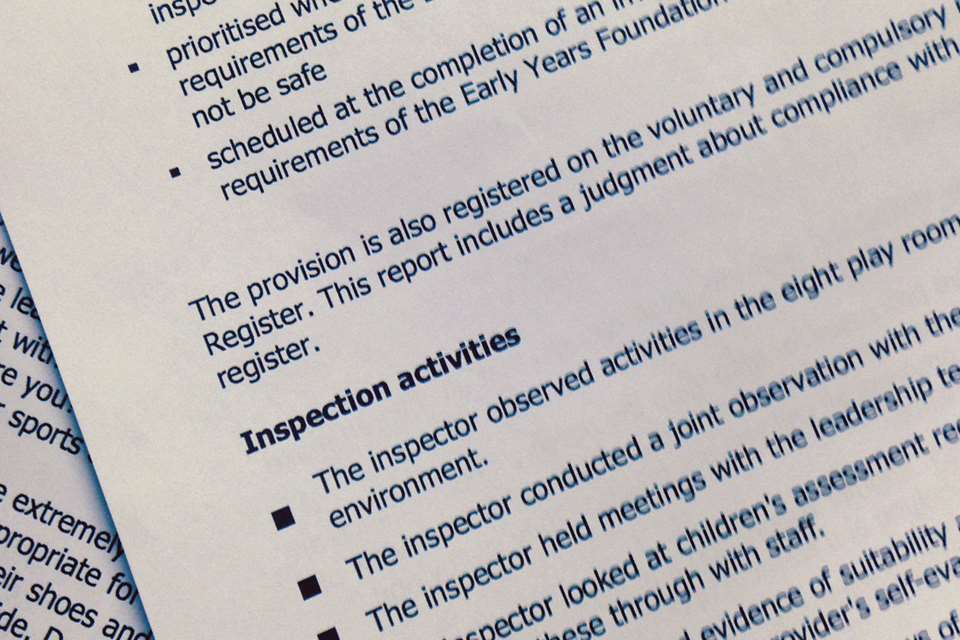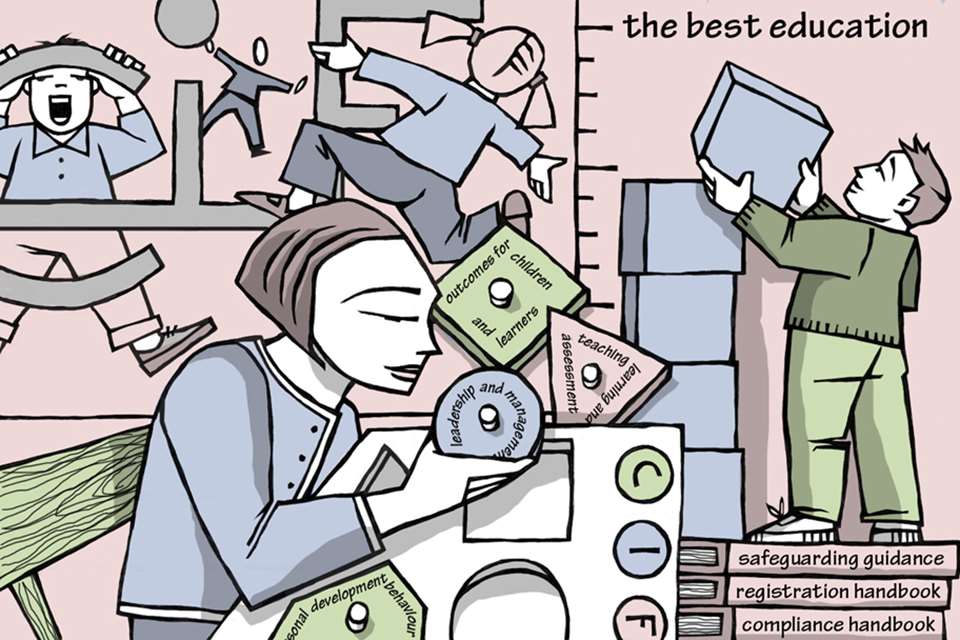Common Inspection Framework: Part 2 - Compare and contrast
Hannah Crown
Monday, August 24, 2015
In the second part of a series on Ofsted's new framework, the Pre-School Learning Alliance's Michael Freeston picks through the paperwork and asks what inspections will look like now

When any policy change occurs, a raft of accompanying guidance emerges alongside. The Common Inspection Framework (CIF), designed to bring together the inspection frameworks for early years, schools, further education and skills, necessarily has its fair share. For the early years sector there are no less than three relevant new handbooks plus a summary guide to the new arrangements entitled The Future of Education Inspection: understanding the changes. This is in addition to the compliance and registration guidance already in existence.
The accompanying documents talk about the new focus, and detail how inspections will be undertaken, what they cover and judgements that will be made. The relevant documents are:
- The Common Inspection Framework: education, skills and early years
- Inspection Handbook (there is one for each of the sectors within Ofsted's education remit, ie early years, maintained schools and academies, non-association independent schools and further education and skills)
- Inspecting Safeguarding in Early Years, Education and Skills Settings
Which handbook early years provision will be inspected under depends on the type of provision itself. Private, voluntary and independent (PVI) group provision and childminders registered with Ofsted will be inspected under the Early Years Inspection Handbook, whereas provision in nursery schools and nursery classes in schools will be subject to the School Inspection Handbook.
It is worth remembering the aim of the CIF: to 'provide greater coherence across different providers that cater for similar age ranges. It ensures more comparability through inspection when children and learners move from one setting to another. It supports greater consistency across the inspection of different remits' (The Common Inspection Framework, paragraph 2). Also, 'inspection promotes improvement by providing challenge and impetus to act' on the part of providers (para 10). The document outlines the focus in CIF on ensuring children are helped and protected and that particular attention will be paid by inspectors to provision for children from a range of particular groups.
The CIF itself outlines the areas under which graded judgements will be made, using the existing scale of 'outstanding', 'good', 'requires improvement' and 'inadequate'. These are: effectiveness of leadership and management; quality of teaching, learning and assessment; personal development, behaviour and welfare; outcomes of children and learners.
From these grades, inspectors will make an assessment of the 'overall effectiveness' of the provision, evaluating 'what it is like to be a child, learner or other user in the provision'.
The new graded judgements represent a change from the current three key judgements made of early years. These focused on:
- how well the provision meets the needs of the range of children who attend
- the contribution of the provision to children's well-being and
- the leadership and management of provision.
Further details of the evaluation schedule (how settings are judged), grade characteristics and sources of evidence are provided in the respective handbooks for each of the sectors.
The change to grade judgement headings makes direct read-across of old and new grade descriptors difficult and practitioners are well advised to start from scratch in evaluating their provision against the new criteria as they prepare for inspection. In doing so, they should be reassured that Ofsted has started from the premise that good practice in early years provision remains good practice. Article 3 in this series will consider the new evaluation schedule and grade descriptors in more detail.
Key operational changes to the process of inspection include the introduction of a half day's notice of inspection for PVI provision, addressing an anomaly that meant school-based provision and childminders received some form of early notification while PVI settings did not. PVI providers will now 'normally receive a telephone call at or just after midday on the working day before the start of the inspection' (para 31, early years handbook).
This is a technical call to inform the setting of inspection, clarify issues about registration status and details of children on roll and make arrangements for the visit. The inspector 'should not use this conversation to probe or start inspecting' (para 33), but that is not to say that from the provider's perspective the inspection has not already begun. The manner, tone and professionalism in which this call is taken will, inevitably, inform an initial impression in the mind of the inspector about the setting, so those who may take the call should be well-prepared for it. The process for schools, which can have a short inspection if rated good at their previous inspection, is outlined here also.
Language
PVI providers will recognise many of the statements in the early years handbook evaluation schedules from previous inspection frameworks. However, this is not always the case with the four key judgments which, being common across all three sector handbooks, sometimes use language that is awkward and challenging when it comes to young children - for example, promoting children's understanding of how to keep themselves safe from abuse, sexual exploitation and extremism (under personal development, behaviour and welfare).
Another important point on the language: the judgements for teaching, learning and assessment and outcomes for children who were once included in the more rounded assessment of how well the provision meets the needs of the range of children who attend are now separate and graded. This highlights a greater focus on children's attainment.
The outcomes criteria make a welcome restatement that Ofsted will assess how children are progressing from their own starting points. But when coupled with references in the teaching and learning criteria to providers having strategies that 'identify children who are falling behind in their learning' (para 152) it appears to imply a focus on attainment, or lack of it, before a child starts compulsory schooling. It is in the personal development, behaviour and welfare judgement that practitioners must look for guidance on wider aspects of development. Inspectors are directed to consider a range of issues relating to emotional attachments, physical and emotional health, self-confidence and self-awareness, but with no reference to the Early Years Foundation Stage (EYFS).
Similarly the language used in the school handbook may present challenges for early years staff in nursery schools or nursery classes in schools. The early years handbook's outstanding grade description for leadership and management refers to a provider that has 'excellent knowledge of the requirements of the EYFS and implements it effectively', while the equivalent school handbook reference becomes 'the broad and balanced curriculum inspires pupils to learn. The range of subjects and courses helps pupils acquire knowledge, understanding and the skills in all aspects of the education including linguistic, mathematical, scientific, technical, human and social physical and artistic learning'.
To support inspectors in writing their section in the school inspection report on the effectiveness of its early years provision, guidance is provided (para 183-190) outlining the expected 'quality and standards'. The grade descriptors 'reflect those in the early years handbook' (para 184) but make no reference to the EYFS, other than to profile data being a measure of children's attainment compared to national figures.
Safeguarding
The final document in the series introducing the CIF is Inspecting Safeguarding in Early Years, Education and Skills Settings. The fact that this area warrants a document of its own reflects growing concerns about the welfare and safety of children and vulnerable adults, including child sexual exploitation, online risks, female genital mutilation and radicalisation and extremism. Being common across all of Ofsted's education sectors, some of the language and references may appear alien to practitioners, but it is essential that providers review their practices in line with this new guidance.
Further consideration of how safeguarding will be inspected within CIF and the requirements relating to the Government's 'Prevent Duty' will be given in part 4 of this series.
KEY FOCUS POINTS OF THE CIF
Leadership and management
- Curriculum
- Ambitious vision
- Promoting fundamental 'British values'
- Safeguarding
Teaching, learning and assessment
- Assessment
- Parents
- The next stage of learning
Personal development, behaviour and welfare
- Self-awareness
Outcomes
- Progress measured from an individual starting point
MORE INFORMATION
Key documents can be found online (www.gov.uk). These include:
- The Common Inspection Framework: education, skills and early years
- The Future of Education Inspection: understanding the changes
- Ofsted Early Years Report 2015
Handbook titles
- Early Years Inspection Handbook
- School Inspection Handbook
- Inspecting Safeguarding in Early Years, Education and Skills Settings
Early years will also have a separate registration handbook and a compliance handbook.








